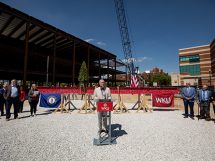By Thomas E. Rutledge
Stoll Keenon Ogden, PLLC
Last Wednesday, May 13, we published a review of the then just-released guidance on the audits of Paycheck Protection Program (PPP) borrowers. But even as we were digesting those developments, two additional changes in the PPP were announced. And then on Friday, May 15, more guidance, the loan forgiveness application, was released.
Another Delay of the Deadline, No Questions Asked
First, the PPP FAQ was supplemented with yet another question/answer (Q 47). Previously, it had been announced that if PPP borrowers returned the borrowed funds by May 7th they would be treated as having made a good faith certification; essentially no harm, no foul. Then, that deadline was extended to May 14th. This last Wednesday, FAQ 47 was published, moving the May 14th deadline to today, May 18th.
You May Be Able to Borrow More Under Your PPP Loan
Second, also on Wednesday, the “interim final rules” on PPP were amended to expand the amount that may be borrowed. Over the course of the PPP, guidance has been issued as to how partners in partnerships (as well as members in LLCs taxed as partnerships) are to be counted in determining the compensation base against which the maximum loan amounts are calculated. In addition, guidance has been issued which alters, and in some cases expands, how seasonal employees are determined, again potentially increasing as to a particular borrower the amount that may be borrowed.
Under the new interim final rules, partnerships/LLCs and seasonal employers may supplement their loan applications and receive additional funds.
On April 14, 2020, SBA posted an interim final rule that, among other things, provided guidance for individuals with self-employment income (85 FR 21747). The interim final rule stated, “if you are a partner in a partnership, you may not submit a separate PPP loan application for yourself as a self-employed individual. Instead, the self-employment income of general active partners may be reported as a payroll cost, up to $100,000 annualized, on a PPP loan application filed by or on behalf of the partnership.” On April 28, 2020, the Department of the Treasury posted an interim final rule that provided an alternative criterion for calculating the maximum loan amount for PPP loans issued to seasonal employers (85 FR 23917).
Some PPP loans were approved to partnerships or seasonal employers before the additional guidance was issued and, as a result, those businesses may not have received PPP loans in the maximum amount for which they are eligible. This interim final rule authorizes all PPP lenders to increase existing PPP loans to partnerships or seasonal employers to include appropriate amounts to cover partner compensation in accordance with the interim final rule posted on April 14, 2020, or to permit the seasonal employer to calculate its maximum loan amount using the alternative criterion posted on April 28, 2020.
In addition, although the interim final rule on disbursements posted on April 28, 2020, requires PPP loans to be disbursed in a single disbursement, if a PPP loan that is increased has already been disbursed, this interim final rule authorizes the lender to make an additional disbursement of the increased loan proceeds.
If you are a partnership/LLC, or a seasonal employer, you should review your initial PPP loan application to see if you can increase the borrowing base and if you can seek an additional disbursement. There is a short window within which you can seek these loan increases, so contact your lender right away to determine whether you can do so.
One open question as to additional PPP loan disbursements is whether they will have their own eight-week covered period, or whether those funds will have their own covered period measured from the supplemental disbursement date.
The PPP Loan Forgiveness Application
Then on Friday, May 15, the Treasury/SBA released the PPP Loan Forgiveness Application (the “Application”); the good news is that it is only eleven pages long. The bad news is that it is eleven pages long. The Application includes a Schedule and a Worksheet that will need to be completed to complete the body of the Application. The Application effects a number of substantive changes in the PPP, including:
• allowing for an alternative eight week covered-period consistent with payroll periods;
• allowing for payroll costs incurred in the covered period to be paid after the period has run provided it is paid on the next regular payroll date; and
• allowing for payment of non-payroll permitted expenses outside the eight-week covered period if paid on or before the next scheduled payment date.
Allowing the use of the borrower’s natural pay-periods in determining what payroll expenses may be properly satisfied with PPP loan funds is a significant liberalization of the rules (that this liberalization may conflict with the wording of the CARES Act is true, but who is going to object? The alternative eight-week covered period is described as follows:
Alternative Payroll Covered Period: For administrative convenience, Borrowers with a biweekly (or more frequent) payroll schedule may elect to calculate eligible payroll costs using the eight-week (56-day) period that begins on the first day of their first pay period following their PPP Loan Disbursement Date (the “Alternative Payroll Covered Period”). For example, if the Borrower received its PPP loan proceeds on Monday, April 20, and the first day of its first pay period following its PPP loan disbursement is Sunday, April 26, the first day of the Alternative Payroll Covered Period is April 26 and the last day of the Alternative Payroll Covered Period is Saturday, June 20. Borrowers who elect to use the Alternative Payroll Covered Period must apply the Alternative Payroll Covered Period wherever there is a reference in this application to “the Covered Period or the Alternative Payroll Covered Period.” However, Borrowers must apply the Covered Period (not the Alternative Payroll Covered Period) wherever there is a reference in this application to “the Covered Period” only.
As for the payment of non-payroll expenses, the Application provides:
An eligible nonpayroll cost must be paid during the Covered Period or incurred during the Covered Period and paid on or before the next regular billing date, even if the billing date is after the Covered Period.
Ultimately, there is going to be greater flexibility than was anticipated to pay with PPP loan proceeds (i) expenses incurred before but paid during the covered period and (i) expenses incurred during put paid after the end of the covered period.
In an interim final regulation (85 FR 21750), it was provided that “payroll costs include… covered benefits for employees (but not owners).” In effect, “covered benefits” that may be paid from PPP loan proceeds are restricted to those for the benefit of non-owner employees. If this is to be and remain the rule, any exclusion of “covered benefits” paid on behalf of owner/employees, (see lines 6 through 9 of the Schedule A to the Application) is less than obvious. Specifically, the instructions for line 6 do not suggest that group health insurance premiums paid on behalf of an owner need to be backed out of the total paid. Just to keep us on our toes, while the interim final regulation used the term “covered benefits,” that term was not used in the Application.
But just as the Application gives it takes away. For example, while up to the entire principal of the PPP loan is forgivable, the interest (1 percent per annum) is not (at least within the terms of the Application). Hopefully this is a drafting oversight, but who can say?
Using the Application as a Planning Tool
Now that the Treasury/SBA have published the Application, you should use it in planning out your use of funds and maintaining the necessary supporting materials (invoices, payroll records and tax filings, etc.) that you will need in order to submit a successful application. At the same time, as you complete a pro-forma application you can see where your application of PPP loan funds is problematic and adjust your planning accordingly.
Borrower Audits and the $2 Million Safe Harbor, Impact of Affiliate Status
Previously, we have reviewed the “audits” of PPP loans over $2 million. That guidance issued last Wednesday, May 13, (FAQ 46) indicates that the $2 million threshold will be applied to all loans among affiliated companies.
FAQ 46 (in part). Any borrower that, together with its affiliates, [20] received PPP loans with an original principal amount of less than $2 million will be deemed to have made the required certification concerning the necessity of the loan request in good faith.
[20] For purposes of this safe harbor, a borrower must include its affiliates to the extent required under the interim final rule on affiliates, 85 FR 20817 (April 15, 2020).
While this language is less than a model of clarity, applying the rule of construction that every word must be given meaning and no word may be treated as superfluous, we have to assess what is the impact of “together with its affiliates.” An obvious reading is that affiliated borrowers are to be aggregated not only for determining initial eligibility, but as well in applying the $2 million threshold for the safe harbor from further scrutiny.
This reading is buttressed by the Application. The Application provides (p. 3) a check box for the question:
“If Borrower (together with affiliates, if applicable) received PPP loans in excess of $2 million, check here:”
I read this as to “gateway” question/answer by which the lender will “flag” the loan file for whatever audit is going to happen, even if the individual loan being considered for forgiveness is less than $2 million.
And still we are not done. Treasury and the SBA have announced that additional guidance will be released “soon.”
Someday this will be behind us, and we will have a far greater appreciation for assembling an airplane. While in flight. In a thunderstorm.
Thomas E. Rutledge is a member at Stoll Keenon Ogden, PLLC and can be reached at [email protected].




















Add Comment